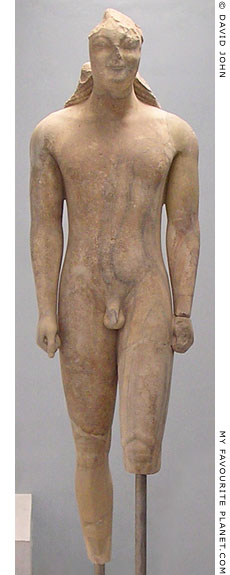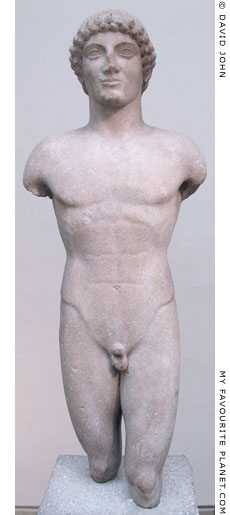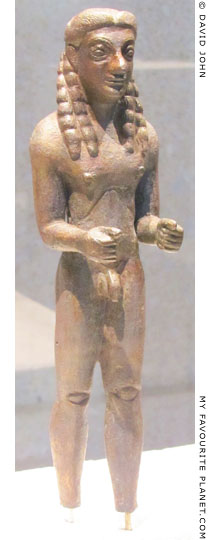|
|
|
| My Favourite Planet > English > Europe > Greece > Northern Aegean > Samos > gallery |
| Samos, Greece |
Samos gallery |
 |
 |
4 of 55 |
 |
 |
|
| |

4.75 metre high "Isches Kouros" statue (see details below), circa 580 BC.
Archaeological Museum, Vathy, Samos. |
| |
Samos Archaeological Museum
(Αρχαιολογικό Μουσείο Βαθέως Σάμου)
The museum consists of two buildings (built 1912 and 1987) in the centre of Lower Vathy. The exhibits include Archaic sculpture, pottery, clay figurines and various small objects made of wood, ivory, bronze and other metals.
It is a fine collection but neither substantial or especially important, and apart from the colossal 4.8 metre high kouros statue, most of the exhibits, although fascinating, are small or fragmentary. This is mainly due to the fact that most of the more historically and artistically important archaeological objects found on Samos (including those from the famous Sanctuary of Hera) are now in other museums around the world (e.g. Athens and Berlin).
Opening times
Summer (1 April - 31 October):
Tuesday-Sunday 09:00-16:00.
Monday closed.
Winter (1 November - 30 April):
Tuesday-Sunday 08:00-15:00.
Monday closed.
Admission 3 Euro; reduced tickets 2 Euro.
Tel: +30 2273 027 469
Website: www.odysseus.culture.gr
An excellent book about the ancient history and archaeology of Samos, and the background to the exhibits in the island's archaeological museums, has been produced by the Latsis Foundation in Athens.
Konstantinos Τsakos and Maria Viglaki-Sofianou, Samos: The archaeological museums. John S. Latsis Public Benefit Foundation and Eurobank Ergasias SA. Published by OLKOS, Athens, 2012.
385 pages. ISBN: 978-960-9590-02-0
The large, lavishly illustrated volume is part of a series of books about Greek archaeological museums produced as limited editions. They are not on sale, but you can read them as e-books in Greek and English at:
www.latsis-foundation.org |
|

Colossus |
|
| |

Face to face. |
| |
| The colossal Isches Kouros |
A 4.75 metre high kouros statue, made around 580-560 BC by a Samian artist using grey-veined Samian marble, probably from the quarries at Manolates, near Karlovasi, on the north of the island. Areas of the figure were highlighted with red and ochre-coloured paint, traces of which are still visible.
The statue is known as the "Isches Kouros" due to the inscription chiselled vertically on the front of the left thigh, which states:
Ἴσχης ἀνέθηκεν ὀ ῾Ρήσιος
"Isches son of (or of the tribe of) Rhesios dedicated me."
Inscription IG XII,6 2:560.
Several authors have pointed out that this advertisement by the donor would have been conveniently at eye level to impress those who saw the statue.
It was among possibly 5 or 6 equally large kouros statues erected along the north side of the 6 km long Sacred Way, which led from the ancient city of Samos (today Pythagorio) to the Sanctuary of Hera (Heraion), the island's patron goddess. The south side of the Sacred Way was lined with inscribed decrees.
At the time these sculptures were produced, Polykrates' enormous Temple of Hera, which was to be the largest in Greece, had yet to be built, and the buildings of the Heraion were still of relatively modest dimensions. In this context the scale of these giant statues, unprecedented in Greece, must have astonished the public for whom they were created.
The first scattered fragments of the broken kouros, the lower right leg and knee, had been discovered during World War II. The left forearm and the left thigh were discovered by chance in 1974, during excavations by the German Archaeological Institute (Deutsches Archäologisches Institut), to the north of the paved road of the Roman Imperial period along the Sacred Way, east of the Heraion. The massive torso was found in 1980, and the parts were assembled and set up in the newly-built museum. The room in which it stands had to be especially modified to accommodate the enormous sculpture.
Helmut Kyrieleis of the German Archaeological Institute, director the excavations at the Heraion from 1976 to 1984, described the excitement of the moment when the head was finally unearthed in autumn 1984:
"On the second day, while we were still in the process of clearing the area before the excavation proper, we came across a large fragment of marble. It is hard to describe our joy and elation as we turned it over and saw the face of the kouros. Rarely are the most secret desires of an archaeologist so swiftly fulfilled beyond expectation. With this fortunate find came the awareness of how much vitality and power had been missing from the kouros until then." [1]
In ancient Greece, a kouros (κούρος, plural kouroi) was a youth, especially one of noble rank. In modern times this name is given to Greek statues of young men made during the Archaic period (800-480 BC). A koré (κόρη, maiden; plural korai, or in modern Greek κόρες, kores) is a statue of a young woman in a similar style. Statues of this type were first made around 640 BC, and remarkably began appearing all over Greece within a few years. Surviving examples range from small bronze statuettes to the colossal stone kouroi of Samos and Thasos. The type continued to be produced and developed until the early 5th century BC.
The tall, athletic, naked male kouroi figures are shown standing stiffly upright, with their arms at their sides, and with one leg stepping forward. The female korai statues are clothed in a peplos or chiton, often with one arm raised and holding an offering to a deity. The statues were brightly painted, and the clothing of the korai was often decorated with incised or painted symbols and motifs.
It is thought that the Greeks learned to make sculptures in this manner from the Egyptians, but developed the style in their own way, gradually making them free-standing without further supports, and adding more natural, lifelike qualites, anatomical detail and geometric proportions. The famous "enigmatic smile" of early Archaic kouroi gradually disappeared, as can be seen in a later kouros in the photo, right.
Many kouroi were dedicated to Apollo, and korai often hold attributes (for example a pomegranate) of a goddess such as Persephone. However, it is not certain whether the statues were meant to represent gods or mortals. The kouroi may have depicted victorious athletes or heroes, and the korai deceased women of noble families. It has also been suggested that they represented mythical or legendary characters of former ages, seen by the Greeks as literally larger than life, from which tribes and aristocratic families claimed descent.
By the late Archaic period some Greek sculptors were becoming increasingly ambitious and made more elaborate figures in dynamic poses, for example in the Gigantomachy group on the east pediment of the Old Temple of Athena on the Athens Acropolis, circa 525 BC (see photo on Athens Acropolis gallery page 18). Such innovations in technique and style led to the revolutionary works of the Classical period.
Other kouros statues on My Favourite Planet:
A smaller kouros in Samos Archaeological Museum:
Samos gallery page 5
A bronze kouros statuette in the Daedalic style in Delphi:
Daidalos page, MFP People section
Twin kouroi of "Kleobis and Biton" in Delphi:
Dioskouroi page, MFP People section |
|

"The Ram-Carrier of Thasos",
an unfinished 3.5 metre tall
kouros statue made from a
single piece of marble,
circa 600 BC.
Found at the Sanctuary of Apollo
on the acropolis of Thasos, Greece.
Thasos Archaeological Museum. |
| |

An early 5th century BC kouros,
known as "the Strangford Apollo",
demonstrating the development
of naturalism and anatomical
detail in Archaic Greek sculpture.
Perhaps from Anaphe island
in the Cyclades. Height 101 cm.
British Museum, London.
GR 1864.2-20.1 (Sculpture B475).
From the Strangford Collection. |
| |
| |
| Samos |
Notes, references and links |
 |
|
1. Discovery of the Isches Kouros
Helmut Kyrielis, The Heraion at Samos, pages 149-152, in Greek Sanctuaries: New Approaches, edited by Nanno Marinatos and Robin Hägg. Chapter 7, pages 125-153, translated by Judith Binder. Routledge, London, 1995.
See also:
601402: Kolossaler Kouros aus dem Heraion in Samos, sogenannte Isches-Kouros, University of Köln Arachne website:
http://arachne.uni-koeln.de/item/objekt/601402
Most of the serious literature dealing directly with this kouros is in German:
Helmut Kyrieleis, Neue archaische Skulpturen aus dem Heraion von Samos, pages 35-45, in Archaische und klassische griechische Plastik I, edited by Helmut Kyrieleis. Mainz, 1986.
Helmut Kyrieleis, Samos X. Der grosse Kuros von Samos. Deutsches Archäologisches Institut. R. Habelt, Bonn, 1996.
H. J. Kienast, Ausgrabungen im Heraion von Samos 1980/81. AA, 1985.
K. Stemmer (Hrsg.), Standorte. Kontext und Funktion antiker Skulptur. Ausstellungskatalog Berlin (Berlin 1995). 139 Kat. Nr. B 22. |

Bronze statuette of a kouros
bearing offerings, from the
Sanctuary of Hera, Samos.
Archaic, circa 570-560 BC.
Neues Museum, Berlin.
Inv. No. Sa 12. |
| |

Bronze statuette of a kouros
from the Sanctuary of Hera,
Samos. Archaic, circa 550 BC.
Altes Museum, Berlin.
Inv. No. Misc. 31098. |
| |
Photos, maps and articles: © David John 2003-2019,
except where otherwise specified.
All photos and articles are copyright protected.
Images and materials by other authors
have been attributed where applicable.
Please do not use these photos or articles without permission.
If you are interested in using any of the photos for your website,
publication or project, please get in contact.
Higher resolution versions are available on request.
Some of the information and photos in this guide to Samos
originally appeared in 2003-2004 on davidjohnberlin.de.
My Favourite Planet makes great efforts to provide
comprehensive and accurate information across this website.
However, we can take no responsibility for inaccuracies or changes
made by providers of services mentioned on these pages. |
| |
 |
Visit the My Favourite Planet Group on Facebook.
Join the group, write a message or comment,
post photos and videos, start a discussion... |
|
|
| |
|
|
| |
| |
 |
| |
 |
| |
 |
| |
 |
| |
 |
| |
 |
| |
George Alvanos
rooms in
Kavala's historic Panagia District
Anthemiou 35,
Kavala, Greece
kavalarooms.gr
|
| |
Olive Garden Restaurant
Kastellorizo,
Greece
+30 22460 49 109
kastellorizo.de
|
| |
Papoutsis
Travel Agency
Kastellorizo,
Greece
+30 22460 49 286
greeklodgings.gr
|
| |
|